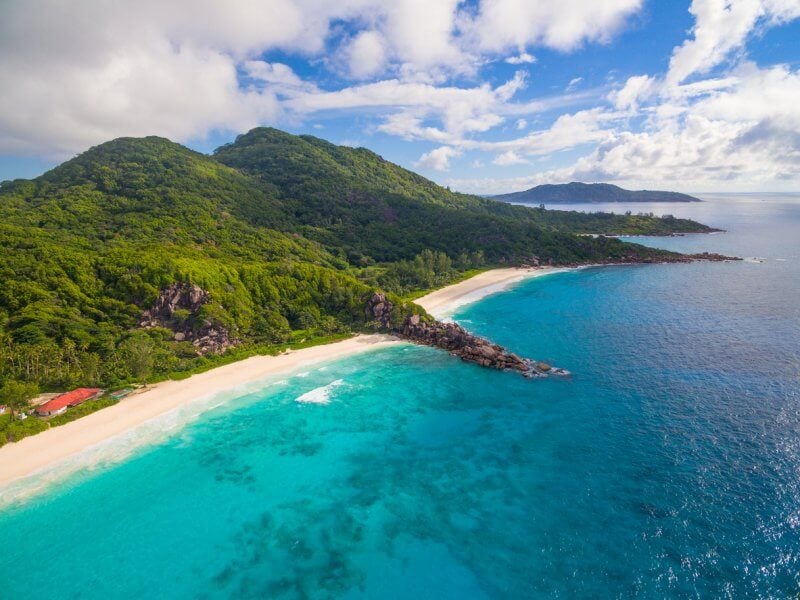The island of La Digue is the fourth largest in the chain of the Seychelles archipelago, but this does not make it so important. Picturesque panoramic landscapes, turquoise ocean waters, beaches with soft sand and huge granite boulders, lush greenery of exotic vegetation, unusual entertainment – all this, like a magnet, attracts film directors, photographers and ordinary travelers to this corner of the Seychelles.
General information
La Digue Peninsula is located in the Indian Ocean and is part of the Seychelles Archipelago. From the largest island of the Seychelles, Mahe, it is separated by 43 kilometers, from Praslin-another large island-only 6 kilometers. The area of La Digue is quite small – just over 10 km2, with a maximum width of 3.3 km.
La Digue was discovered in 1744, and the name was given to it only in 1768, when the navigator Marc Joseph Marion-Dufresne visited it.
La Digue belongs to the State of Seychelles. The capital of the island is the small village of La Passe.
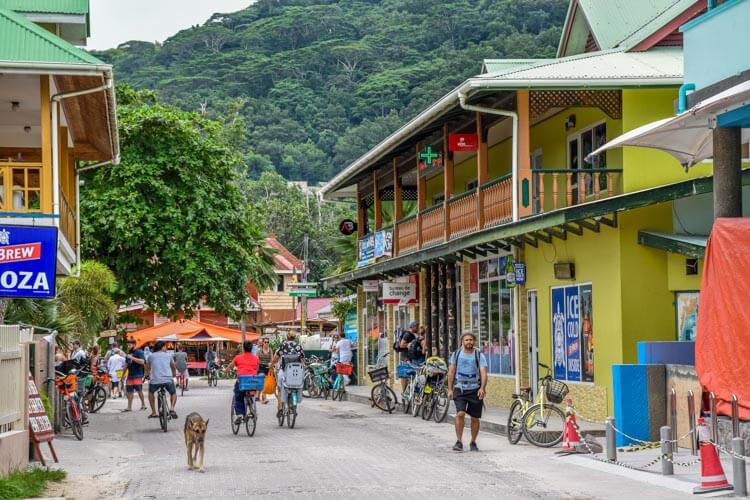
Due to the small area of the island and the large-scale jungle thickets that cover most of the land, the main transport here is ox sleds, bicycles and scooters. Previously, there was a ban on the use of motor vehicles on this island of Seychelles, but now there are already taxis and even an auto repair shop.
Useful to know! You can rent a bike on La Digue immediately upon arrival – there are rental services at the pier.
The small population of the island – about 2,500 people – lives in La Passe. Tourism is the main source of income for local residents.
The main reason why tourists go to relax on this island of the Seychelles – luxury sandy beaches. On this site, you can view an up-to-date map of La Digue Island with its beaches, as well as find out the most important information about them.
Beaches are the main attraction of La Digue Island
Among the attractions of La Digue in the Seychelles, you can name the old Creole wooden houses in La Passe, as well as the graves of the first colonizers from the island of Bourbon (Reunion), located in the northern part of La Digue, on Cape Barbie.
Interesting fact! The main man-made attraction of La Digue is a Creole-style bungalow built in the 18th century. In 1977, it was used for filming some scenes of the French film “Goodbye, Emmanuel!”. The President of Seychelles now lives in this bungalow.
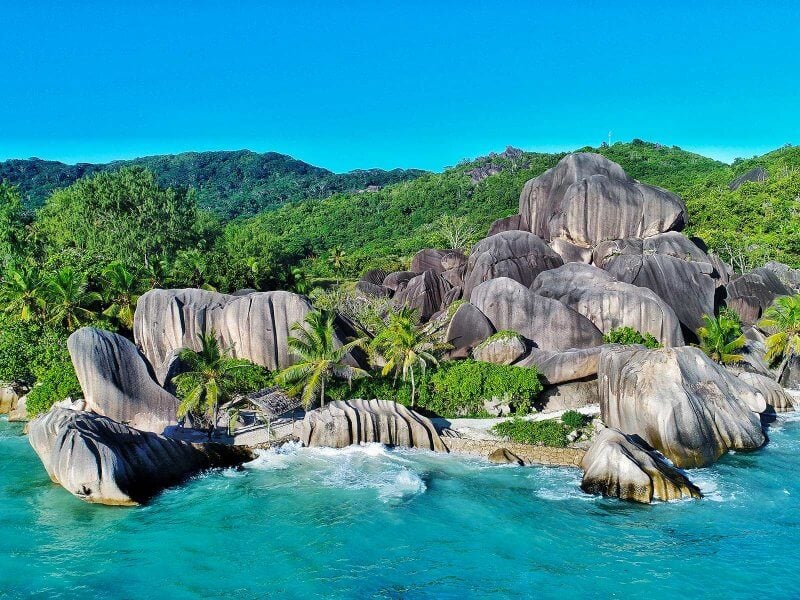
Still, La Digue is mostly interesting for its natural attractions. In general, the entire coastline of the island is a series of picturesque bays with beaches. Covered in snow-white sand and decorated with sculptural boulders, they are surrounded by granite hills and dense jungle. Because of the high waves, swimming off the coast of La Digue Island is very difficult, and in some places even dangerous.
Anse Source D’Argent
Silver Spring Beach – this is how Anse Source D’Argent translates – is not only the most popular beach on the island, but also one of the best in the world. It is his spectacular landscapes that are captured on most postcards and photos advertising La Digue and the Seychelles.
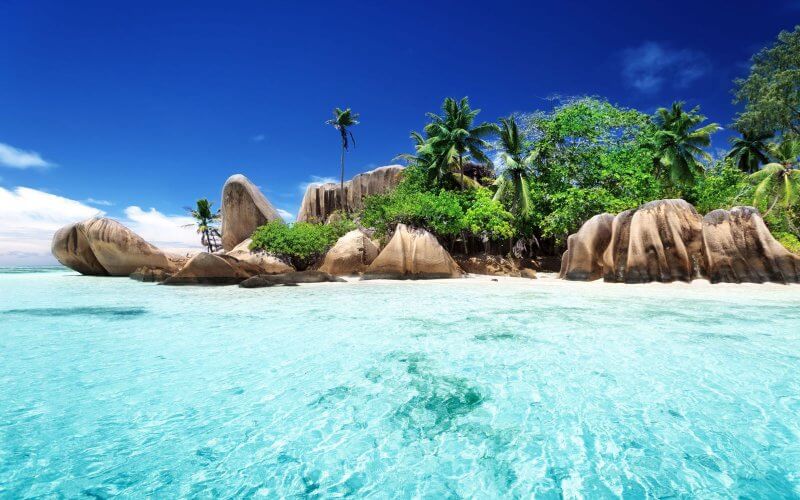
The coastline consists of several small areas separated by huge granite massifs, painted pink in the morning and red at sunset.
Anse Source d’Argent is well protected by a reef, so the ocean here is very calm. The water is clear, but its appearance is sometimes spoiled by algae. It’s very shallow, with soft sand underfoot. All this makes this part of the Seychelles coast ideal and safe for families with children. Anse Source d’Argent is also considered a relatively good spot for snorkeling: the shallow water makes swimming a little pointless, but you can always swim farther away.
The beach is popular and therefore it is always crowded.
There is a restaurant and cafe on site, as well as grocery and souvenir shops.
A tip! The best time to visit Anse Source D’Argent is in the early morning, before the arrival of day tours from Mahe and Praslin.
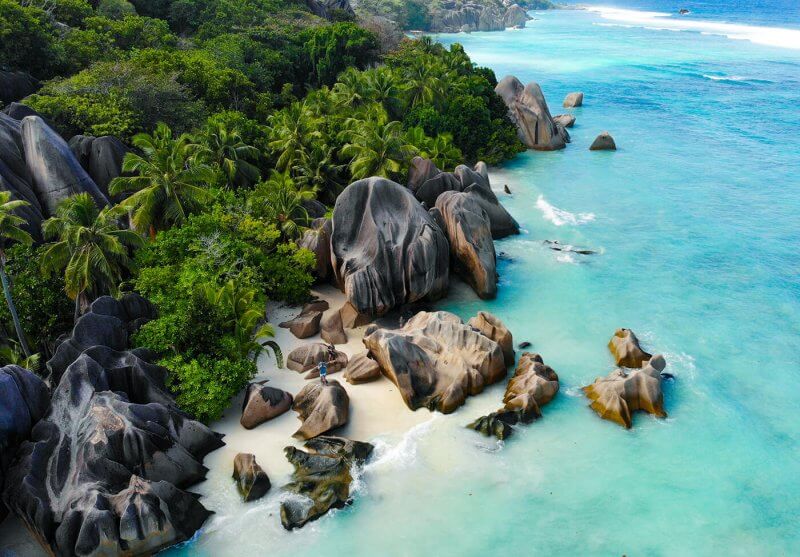
Anse Surce d’Argent is located in the far part of the national park L’Union Estate, which dictates certain restrictions:
- Union Estate Park closes its gates at 17: 00. Accordingly, it is possible to stay on the coast until 17: 00.
- To get to the beach, the entrance fee to L’Union Estate is 115 rupees (approximately $8). This fee also allows you to explore the entire park and visit the museum.
Anse Cocos

Anse Cocos is located in the south-east of the island. This beautiful area of La Digue Island in the Seychelles is ideal for photo and video shooting and, of course, for sunbathing. Swimming in the open ocean on Anse Cocos is quite dangerous due to strong undercurrents and large waves. To do this, it is better to go to the natural pools that are at the end of the beach – there are huge boulders that reliably protect from waves.
Anse Cocos is shaped like a crescent, with rocks flanking the beach, and a bright green jungle growing behind the coastline. The coast is covered with fine white sand and black boulders, the descent into the water is steep and rocky, there are shoals. There are a lot of rocks at the bottom.
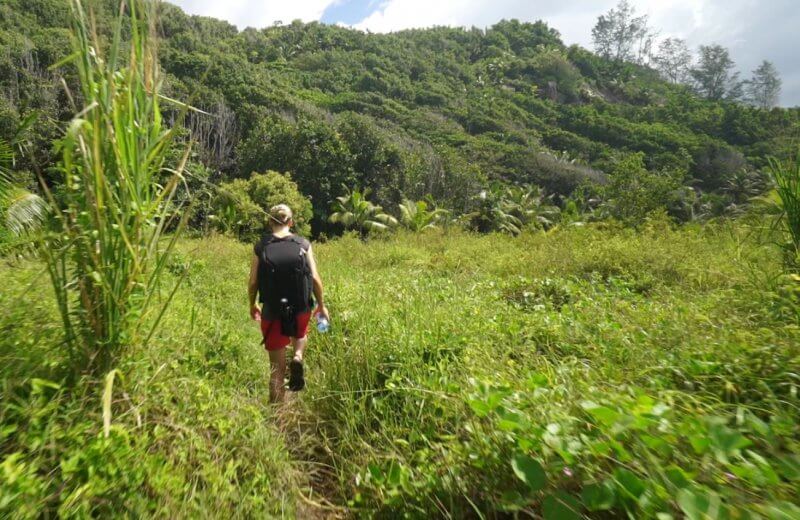
The path to Anse Cocos is unmarked and it is difficult to find the road without a guide. There are organized hiking trips from the Grand Anse resort, you need to walk for 30 minutes. Due to the fact that Anse Cocos is more isolated than other beaches on La Digue Island in the Seychelles, it is not crowded.
The infrastructure there is not developed. Everything you might need for a vacation, including food, should be taken with you.
Grand Anse
In the south-eastern part of La Digue is Grand Anse-the best beach not only in the Seychelles, but also on the planet according to CNN 2013.
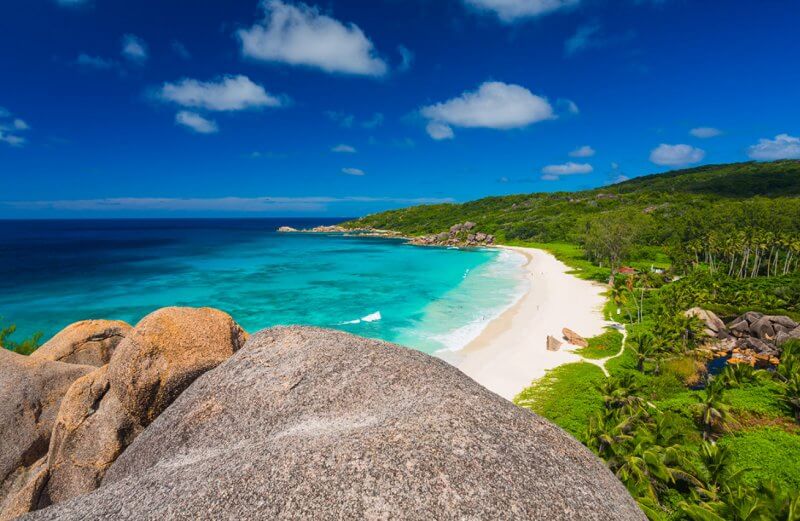
The coast there is wide and long – up to 3 km) – it is the most spacious sandy beach on the island, and it is surrounded by high granite rocks.
Although the waters on Grand Anse look calm and calm, it is dangerous to swim there due to strong undercurrents. People come there mainly to enjoy the breathtaking views.
The infrastructure on Grand Anse is poorly developed, there is a kiosk with drinks on the west side.
A tip! You need to arrive at the Grand Anse as early as possible in order to have time to take a place with guaranteed shade. Until noon, you can still hide under palm trees or protruding rocks, and then only in “burrows” between large boulders.
Petite Anse
La Digue Island in the Seychelles boasts another beautiful beach area located on the east coast.
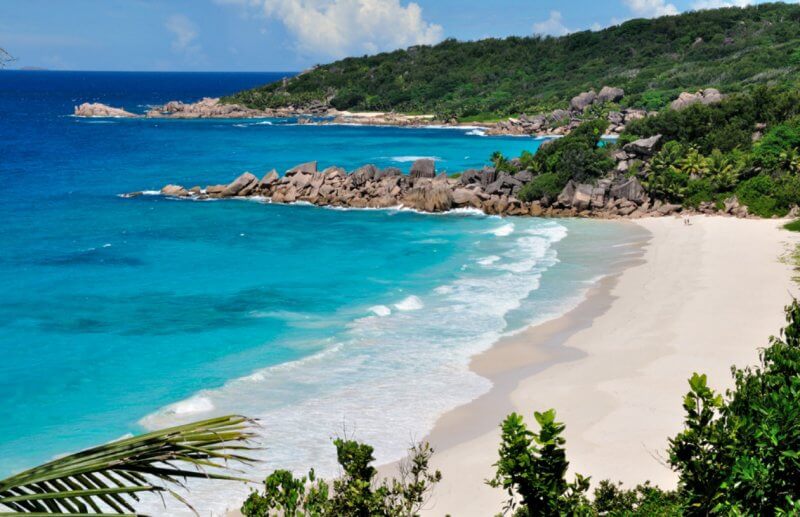
Petit Beach is a secluded wilderness area with no infrastructure. Take water, food, a towel, a panama hat, and sunscreen with you. There is a tiny cafe, and if you buy soft drinks there, you can take shelter in the huts standing around the perimeter. Natural shade can be found among the large rocks.
Due to the strong undercurrents, Petit Anse is not suitable for swimming at all, but it is an ideal place for picnics and sunbathing.
The coast here is covered with fine white sand, but there are stones.
Get to Petit Anse by walking up the hill from Grand Anse beach.
Anse Marron
Anse Marron is a small beautiful beach in the bay of the same name on the south-west coast of La Digue, which can be easily attributed to the island’s attractions. You will have to get to it through forests, climb granite boulders, squeeze through narrow passages between stones. Getting to the beach isn’t easy, but it’s definitely worth the effort.
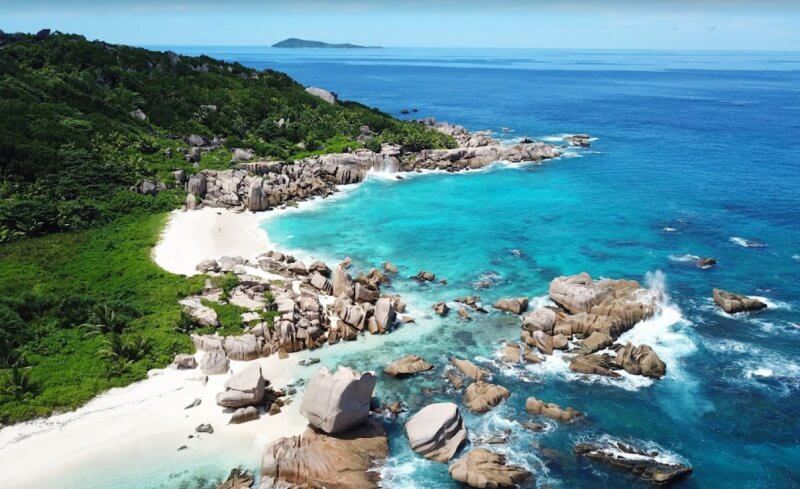
A tip! It is best to make your way to Anse Maron with a guide, and you should bring special coral slippers and sneakers with a “vibram” sole.
There are no hotels or cafes on Anse Marron. Only huge boulders provide shade – you can hide under them, sitting right in the water. The water temperature is very pleasant and comfortable. Although because of the raging waves, swimming and especially swimming is far from recommended!
Anse Severe
Anse Sever is located in the north of the island, near the marina in the town.
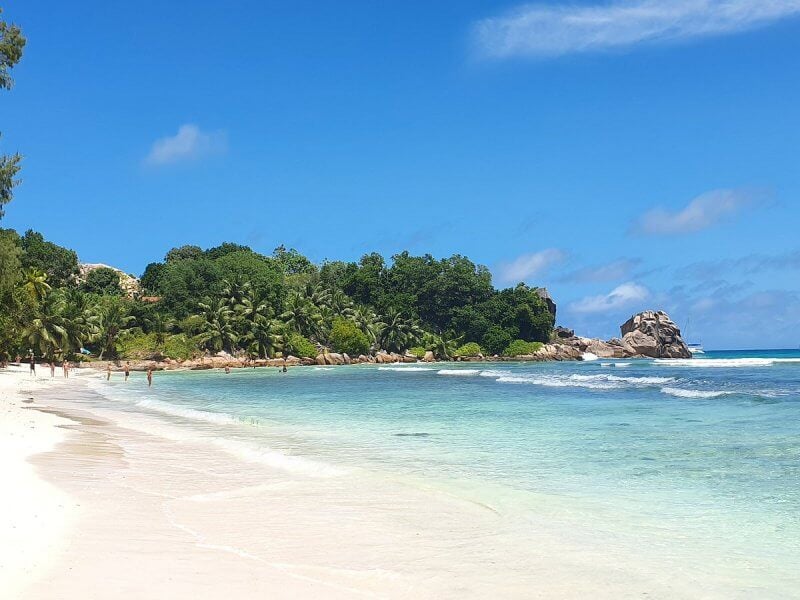
The beach strip is very long and wide (70 meters) at low tide, the tide makes it narrow. In the morning, at low tide, it is incredibly shallow, but after 12 it is quite possible to swim. And in the evening, as everywhere in the spring in the Seychelles, the waves increase and become quite large.
There are almost always a lot of people on Anse Severe – guests of nearby guesthouses and small hotels usually come there – but there is enough space for everyone and no one interferes with each other. The shade provided by the trees growing here is enough for everyone.
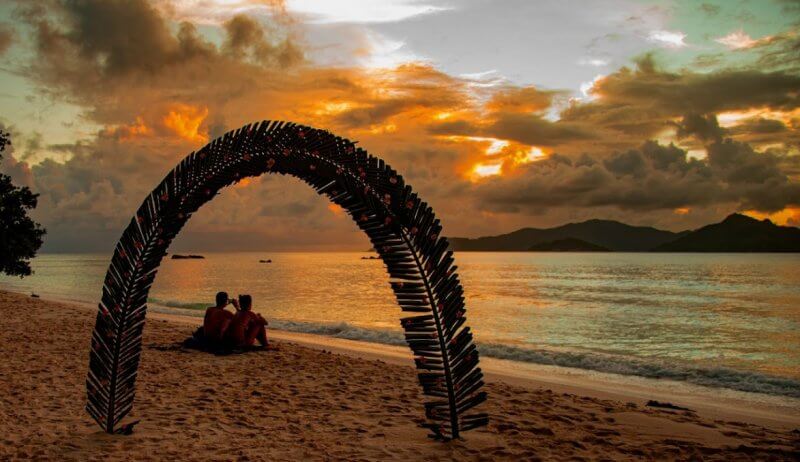
Anse Sever is one of the best snorkeling spots not only in La Digue, but also in the Seychelles archipelago.
At the far, northern end of Anse Severe, there is a small bar, two fairly good guest houses, and a simple gift shop. Next to them walks a large turtle, with which you can take photos for free.
Anse Patates
The beach area of Anse Patat in the north-east of the island belongs to the Patatran Village Hotel, but, like all beaches of La Digue and the Seychelles, admission is free.
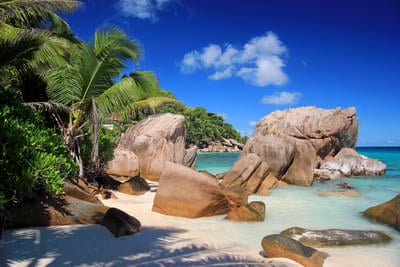
Ans Patat is very small, surrounded by rocks and palm trees. You need to go down to the water by steps, and this descent is quite difficult – sharp, steep, with sharp corals. The depth is quite decent at once, especially at high tide. In the evening, the waves become stronger, which makes it even harder to swim.
However, on Ans Patat, many people venture into the water for the sake of snorkeling, because here is one of the best snorkeling sites in the Seychelles. At low tide, the beach gets shallower, but not far from the shore, the depth is still enough for safe swimming.
Diving and snorkeling in La Digue
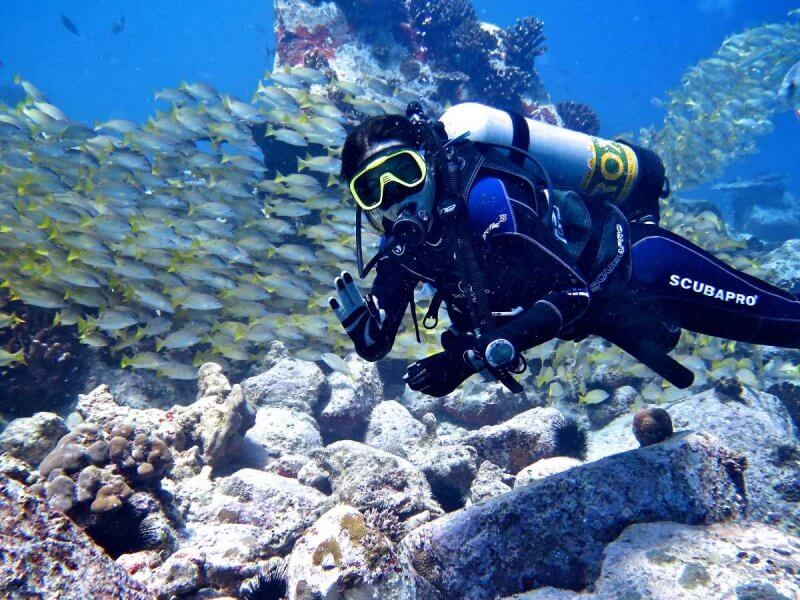
La Digue is considered one of the most popular places in the Seychelles for snorkeling and scuba diving. Not far from the island there are about 30 sites that will introduce you to the underwater world of the Indian Ocean. Diving sites are 15 to 40 minutes away by boat from the coast of La Digue. The depth of dives is kept in the range of 10-30 meters, the relief is represented by granite formations and coral reefs with a variety of underwater inhabitants.
Some of the most famous dive sites in the Seychelles include:
- North Island and Housereef are the most interesting coral reefs in the area that are suitable for everyone. The main condition: you must have good buoyancy skills. Local inhabitants: reef fish, moray eels, eels, sharks of various species.
- “Ave Maria” is a granite cliff with numerous underwater passages, standing around a coral atoll. Among the main local inhabitants are stingrays and reef sharks.
- “Coral Garden” is a place where you can admire a variety of corals.
- Anse Mondon is a great base for diving and snorkeling lessons. Stingrays and sea turtles can be found here.
- White Bank and Channel Rocks are home to lobsters, octopuses, and unicorn fish.
- Black Rock and Flat Rock – there are small caves where you can meet rays, lionfish, blowfish, and angels.
- “West Sister Rock” and “Grand Ser” are able to please with a meeting with gray sharks and large barracudas.
- Richards Reef and Morane Bank-these Seychelles sites with depths of up to 25 meters and a variety of underwater inhabitants are popular for night dives. It should be noted that there are strong undercurrents.
- Anse la Mouche Bay is home to stunning coral reefs: Oscar’s Reef and Alice in Wonderland. There they go night diving and watch the huge clams of Spanish Dancers.
Snorkeling is possible on many beaches of La Digue, in particular, on Anse Source D’Argent, Anse Severe, Patatran Village Hotel. But still, the neighboring islet of Ile de Cocos is more suitable for such activities.
Places for tourists to stay in La Digue
The island of La Digue in the Seychelles has a well-developed hotel infrastructure: there are 7 modern hotels, as well as a couple of dozen mini-hotels, villas and guesthouses with cozy rooms.
Almost all hotels have Internet access, restaurants and spas are open, excursions are organized for visitors, as well as bicycle rental and water diving equipment are offered.
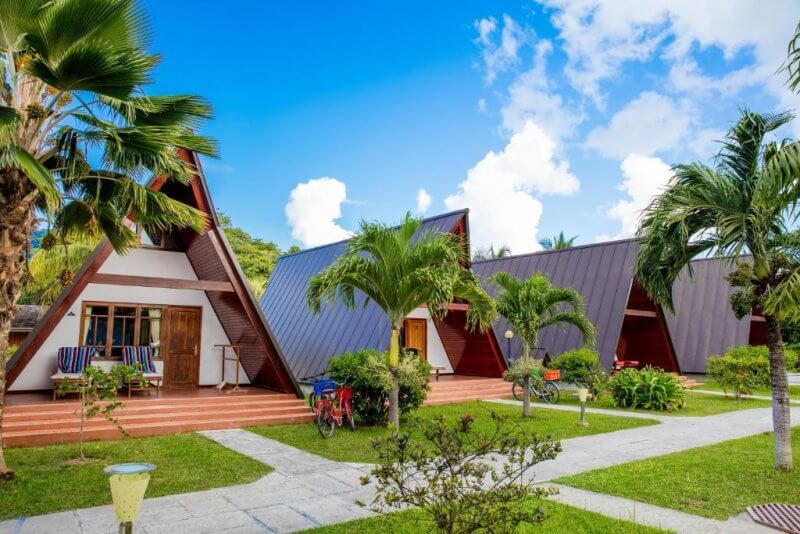
The most popular and comfortable hotels in La Digue are: La Digue Island Lodge, Le Domaine de L’Orangeraie, Le Repaire Boutique and Casa De Leela. Rooms in these hotels cost from $300 per night, and it is advisable to book them several months before the trip.
There are hotels where you can rent rooms at more affordable prices-from $100 per day: Kot Babi, Villa Creole, L’Union Estate Beach Chalets.
Local residents rent their houses to tourists even cheaper-from $50 per day.
How to get to La Digue
There are two ways to get to La Digue on arrival in the Seychelles. You can get there directly from Mahe Island, where the Seychelles International Airport is located. Or you can fly from Mahe on a domestic plane to Praslin, and then go to Li Ding from there.
Ferryboat
There is usually a daily ferry service between Mahe and Praslin, as well as Mahe and La Digue. Cat Cocos ferries between Mahe and La Digue almost always stop at Praslin Island. In addition, 1-2 times a day you can get from Mahe to La Digue by high-speed catamaran, which operates a direct flight.
The water ride from Mahe Island takes 1 hour and 45 minutes, and the ferry from Praslin to La Digue takes 30 minutes.
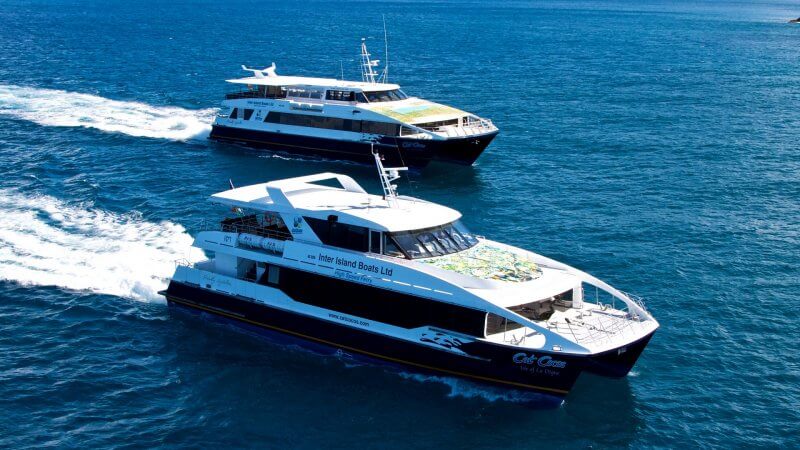
It is profitable to book a ferry ticket on the website www.seyferry.com. In this case, prices are approximately $13 less than when buying tickets at the port’s ticket office.
There are 3 classes available:
- Economy class on the Main deck (Main cabin, Coco De Mer). The full ticket price for the Mahe – La-Digue flight is $70, while the ticket price for children aged 2-12 is $35.
- Economy class on the upper deck (Island Hopper). A ticket for adults and children costs $75 and $40.5, respectively.
- Business Class (Lazio Lounge) offers tickets at the following prices: adults $93, children $52.
In Mahe, the airport and ferry pier are connected by a special bus. The trip duration is 15-25 minutes. Travel for an adult is $11.5, for a child $6. You can also take a taxi, which costs $35-40.
Helicopter
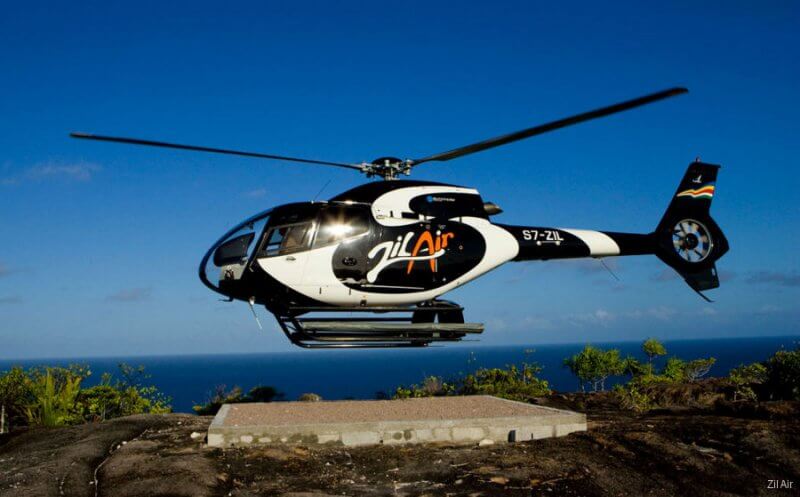
There is another way to get from Mahe and Praslin to La Digue: use the services of Helicopter Seychelles or Zil Air, which provide transfers between the Seychelles Islands by helicopter.
Of course, the flight will cost several times more than a ferry ride, but the travel time is much shorter: from Mahe to the island of La Digue, you can fly in just 10 minutes.
Silhouette – the most undeveloped of the Seychelles islands

